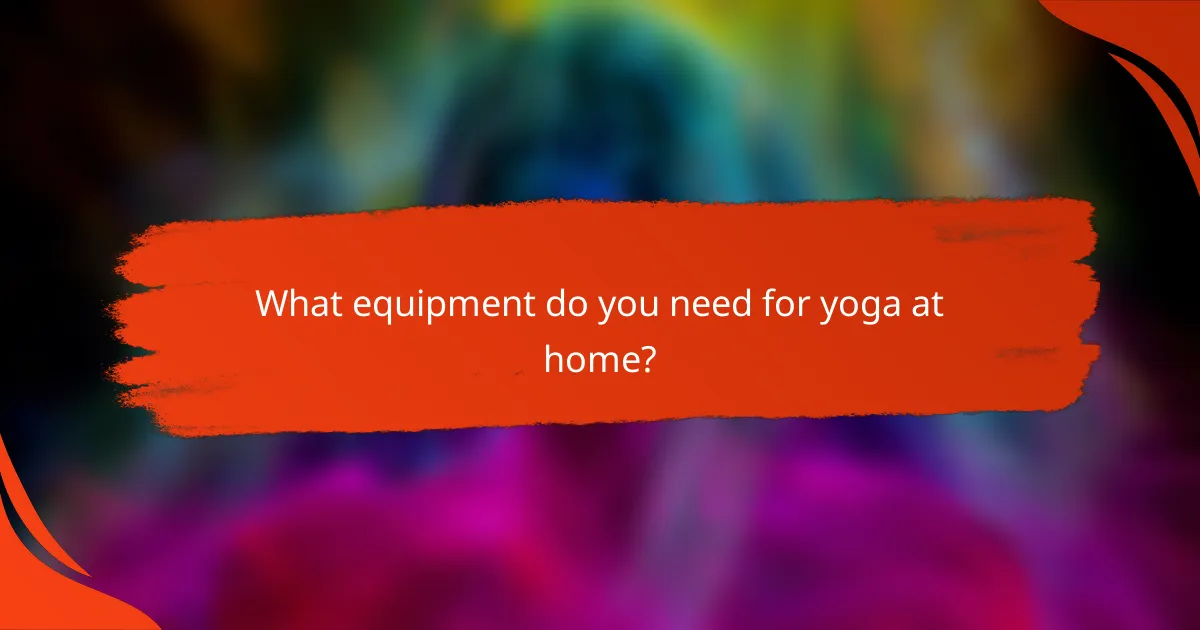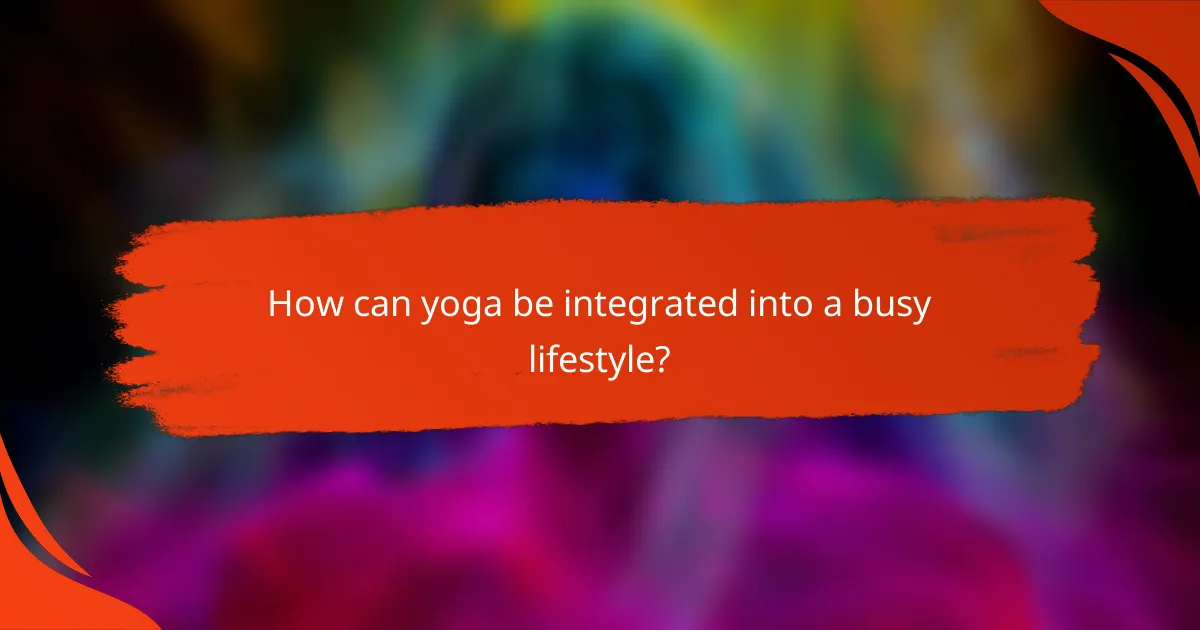Incorporating a daily yoga routine can greatly enhance your overall well-being by fostering physical health, mental clarity, and emotional stability. By practicing regularly, you can cultivate mindfulness, reduce stress, and improve flexibility, ultimately leading to a more balanced and fulfilling lifestyle.

How can a daily yoga routine improve well-being?
A daily yoga routine can significantly enhance overall well-being by promoting physical health, mental clarity, and emotional stability. Regular practice helps individuals cultivate mindfulness, reduce stress, and improve flexibility, leading to a more balanced lifestyle.
Enhanced mental clarity
Yoga encourages mindfulness and focus, which can lead to improved mental clarity. By practicing breath control and meditation techniques, individuals can sharpen their concentration and enhance cognitive function. This can be particularly beneficial for those facing daily distractions or information overload.
Incorporating poses that require balance and coordination can further stimulate brain activity. Simple practices like the Tree Pose or Warrior III can help develop focus and awareness, making it easier to tackle complex tasks throughout the day.
Reduced stress levels
Engaging in a daily yoga routine can significantly lower stress levels by activating the body’s relaxation response. Techniques such as deep breathing and gentle stretching help reduce cortisol, the stress hormone, promoting a sense of calm. Regular practice can lead to a more resilient response to stressors.
To maximize stress reduction, consider incorporating restorative poses like Child’s Pose or Legs-Up-The-Wall into your routine. These poses encourage relaxation and can be practiced at any time of day, especially after a long workday.
Increased energy
A consistent yoga practice can boost energy levels by improving circulation and oxygen flow throughout the body. Dynamic sequences, such as Sun Salutations, can invigorate the body and mind, making it easier to stay active and engaged. Many practitioners report feeling more energized after a session.
To enhance energy, focus on morning yoga sessions that incorporate sun salutations and energizing poses like Downward Dog and Cobra. This can set a positive tone for the day ahead and help combat fatigue.
Improved emotional balance
Daily yoga practice fosters emotional balance by encouraging self-awareness and acceptance. Through mindfulness and meditation, individuals can better understand their emotions and reactions, leading to healthier coping mechanisms. This can be particularly beneficial during challenging times.
Incorporating poses that open the heart, such as Camel Pose or Bridge Pose, can help release pent-up emotions and promote a sense of well-being. Regularly practicing gratitude and reflection during yoga can further enhance emotional stability and resilience.

What are the best yoga poses for flexibility?
The best yoga poses for flexibility focus on stretching and lengthening muscles, improving range of motion. Incorporating these poses into your routine can enhance overall mobility and reduce the risk of injury.
Downward Dog
Downward Dog is a foundational pose that stretches the hamstrings, calves, and shoulders while strengthening the arms and legs. To perform this pose, start on your hands and knees, lift your hips towards the ceiling, and straighten your legs and arms, forming an inverted V-shape.
Hold the position for several breaths, aiming to keep your heels pressing towards the ground. A common mistake is to let the back round excessively; maintain a straight spine to maximize the stretch.
Pigeon Pose
Pigeon Pose is excellent for opening the hips and stretching the glutes and hip flexors. Begin in a tabletop position, bring one knee forward and place it behind your wrist, extending the opposite leg straight back.
Ensure your hips are square to the ground and lean forward to deepen the stretch. Avoid forcing your body into the pose; instead, ease into it gradually to prevent strain.
Warrior II
Warrior II enhances flexibility in the hips and legs while building strength. Stand with your feet wide apart, turn one foot out 90 degrees, and bend the knee over the ankle while extending your arms parallel to the floor.
Focus on keeping your front knee aligned with your ankle and your back leg straight. This pose not only stretches but also improves balance and stability.
Seated Forward Bend
Seated Forward Bend is a calming pose that stretches the spine, hamstrings, and lower back. Sit with your legs extended in front of you, inhale to lengthen your spine, and exhale as you hinge at the hips to reach towards your feet.
Keep your back straight and avoid rounding your shoulders. If you can’t reach your feet, use a strap or simply rest your hands on your shins to maintain the stretch without straining.

How often should you practice yoga for optimal results?
For optimal results, practicing yoga daily is ideal, but a minimum of three times a week can still yield significant benefits. Regular practice enhances flexibility, strength, and overall well-being, making it essential to find a routine that fits your lifestyle.
Daily practice recommended
Engaging in yoga daily can lead to the best outcomes in terms of flexibility and mental clarity. A consistent daily routine allows your body to adapt and improve gradually, fostering a deeper connection between mind and body. Even short sessions of 15-30 minutes can be effective if done regularly.
Consider incorporating various styles of yoga throughout the week, such as Hatha for strength and Yin for relaxation. This variety can keep your practice engaging and cater to different physical and mental needs.
Minimum three times a week
If daily practice feels overwhelming, aim for at least three sessions per week. This frequency can still provide substantial benefits, helping to maintain flexibility and reduce stress. Consistency is key; try to schedule your sessions at the same time each week to build a habit.
To maximize your practice, focus on quality over quantity. Each session should be mindful, allowing you to connect with your breath and movements, even if the duration is shorter than a daily routine.
Consistency over intensity
When it comes to yoga, maintaining a consistent practice is more beneficial than pushing yourself to practice intensely. Regular, gentle sessions can lead to greater improvements in flexibility and strength compared to sporadic, high-intensity workouts. Aim for a steady rhythm that fits your lifestyle.
To foster consistency, consider setting realistic goals and tracking your progress. This could be as simple as noting the days you practice or the poses you master. Celebrate small achievements to stay motivated and committed to your yoga journey.

What equipment do you need for yoga at home?
To practice yoga at home effectively, you need a few essential pieces of equipment that enhance your comfort and support your practice. The most important items include a yoga mat, yoga blocks, and a strap for support, each serving a unique purpose in your routine.
Yoga mat
A yoga mat provides a non-slip surface that enhances stability during poses. It typically measures around 60 cm wide and 180 cm long, with thickness varying from about 3 mm to 8 mm, depending on your comfort preference.
When choosing a mat, consider materials like PVC, TPE, or natural rubber, as they offer different levels of grip and cushioning. Look for a mat that is easy to clean and durable, as regular use can wear down lower-quality mats quickly.
Yoga blocks
Yoga blocks are supportive tools that help you achieve proper alignment and deepen stretches. They come in various materials such as foam, cork, or wood, with foam blocks being lighter and more portable.
Using blocks can assist beginners in reaching poses that might be challenging without support. They can also be used to modify poses for those with limited flexibility, making your practice more accessible and enjoyable.
Strap for support
A strap is a versatile tool that aids in stretching and improving flexibility. Typically made of cotton or nylon, straps can be about 2 to 3 meters long, allowing you to reach limbs that may be difficult to grasp otherwise.
Straps are particularly useful for poses that require extended reach, helping to maintain proper form and alignment. When using a strap, ensure it is securely fastened to avoid slipping during your practice.

What are the prerequisites for starting yoga?
To start yoga, you need no specific prerequisites, making it accessible to everyone. A willingness to learn and a few basic items will set you on the path to practice.
No prior experience needed
Yoga is designed for all levels, from beginners to advanced practitioners. You don’t need any prior experience to join a class or start practicing at home. Many studios offer introductory classes specifically tailored for newcomers.
As a beginner, focus on learning the fundamental poses and breathing techniques. Over time, you will build your skills and confidence, allowing you to explore more complex practices.
Comfortable clothing
Wearing comfortable clothing is essential for a successful yoga practice. Opt for breathable, stretchy fabrics that allow for a full range of motion. Common choices include yoga pants, leggings, or shorts paired with a fitted top.
Avoid overly loose clothing, as it may hinder your movements or become a distraction during poses. Ensure that your attire is suitable for the climate, especially if you are practicing in a heated environment.
Open mindset
Having an open mindset is crucial when starting yoga. Approach your practice with curiosity and a willingness to learn, rather than striving for perfection. This attitude will help you enjoy the journey and embrace the challenges that come with it.
Be prepared to adapt your practice based on your body’s needs and limitations. Remember that yoga is a personal experience, and comparing yourself to others can detract from your progress and enjoyment.

How can yoga be integrated into a busy lifestyle?
Yoga can be seamlessly integrated into a busy lifestyle by incorporating short, focused sessions throughout the day. This approach allows individuals to reap the benefits of yoga without requiring extensive time commitments.
Short sessions of 10-15 minutes
Short yoga sessions of 10-15 minutes can be effective for maintaining flexibility and reducing stress, even in a packed schedule. These brief practices can be done in the morning to energize your day, during lunch breaks to refresh your mind, or in the evening to unwind.
To make the most of these short sessions, focus on specific poses that target areas of tension or stiffness. For example, a quick routine might include downward dog, cat-cow stretches, and seated forward bends. This can help improve flexibility and promote relaxation.
Consider setting reminders on your phone or using yoga apps that offer quick routines. Avoid the pitfall of skipping these sessions by treating them as essential appointments in your day. Consistency is key to experiencing the cumulative benefits of yoga.


